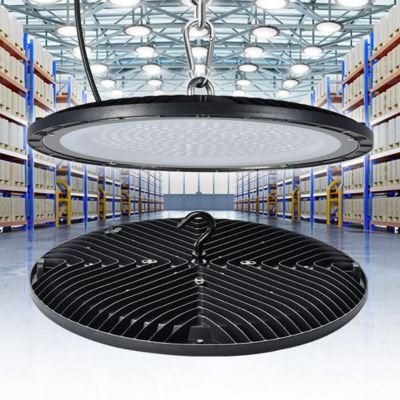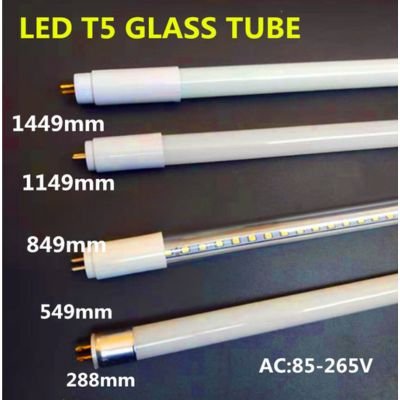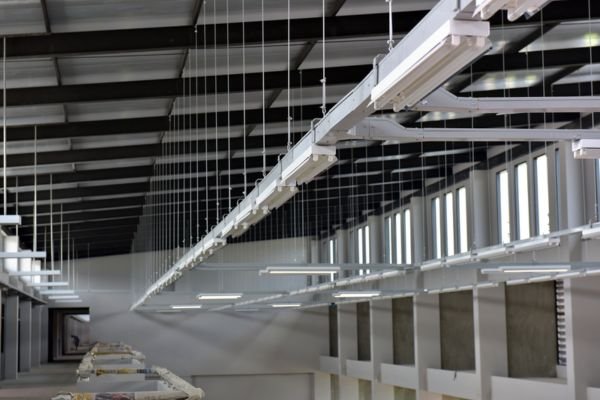Did you know that upgrading to LED warehouse lighting can cut energy costs by up to 70%?”
Warehouse lighting is crucial for ensuring efficient operations and safety in both small and large warehouses. Utilizing suitable LED lighting can significantly reduce energy consumption.
This guide will outline the various types and features of warehouse lighting, providing insights on how to select the optimal lighting solution for your warehouse project.
Table of Contents
Key Factors to Consider When Choosing Warehouse Lighting
Choosing the right warehouse lighting doesn’t have to be complicated. By focusing on several core factors, you can buy the best products for your specific needs.
How many lumens for warehouse lighting?
Generally, different functional areas require distinct brightness levels to ensure optimal illumination.
The sorting area requires 300-500 lux to ensure workers can clearly read product labels without straining their eyes.
The storage area requires 100-200 lux, enabling workers to navigate safely and allowing security cameras to capture clear video footage, while also minimizing energy consumption.
Outdated Warehouse Lighting vs. Modern LED Solutions
Older warehouses often utilize traditional lighting technologies like fluorescent lamps and metal halide fixtures. While once common, these systems are increasingly being replaced by superior LED warehouse lighting. The shift towards LEDs is driven by key benefits, particularly energy efficiency and improved operational features.
Why Upgrade to LED Warehouse Lighting?
- Significant Energy Savings: Compared to conventional lighting, LED lights can reduce energy consumption by as much as 70%. This efficiency translates directly into lower operating costs.
- Improved Safety Profile: LEDs generate considerably less heat than traditional bulbs. Their surface temperature typically remains under 120°C, drastically minimizing the potential fire hazards associated with older, hotter lighting systems.
- High Luminous Efficiency: LED technology offers superior brightness per watt, typically delivering 80-120 lumens per watt (LM/W). This is approximately three times the efficiency of traditional lamps, providing better illumination.
- Reduced Electrical Load: Because LEDs draw less power for the same (or better) light output, they decrease the strain on your warehouse’s electrical circuits, further enhancing electrical safety.
Selecting LED Color Temperature (CCT & CRI) for Warehouse Lighting
LED lighting commonly offers choices in Correlated Color Temperature (CCT), with the main options being:
- Cool White (5000K-6500K):A popular choice for its bright, alert feel, suitable for many general warehouse applications.
- Warm White (2700K-3500K):Provides a softer, yellowish light, often preferred in specific situations.
Addressing Blue Light Sensitivity
A key consideration with cool white LEDs is their emission of blue light. While often imperceptible to the eye, this blue light can negatively impact blue light-sensitive materials. If your warehouse stores items vulnerable to blue light degradation, such as UV-curable adhesives (UV glue), specific films, or photosensitive chemicals, it’s crucial to minimize exposure. The simplest solution is often selecting LEDs with a warm white CCT (2700K-3500K), which naturally emit less blue light. Specialized low-blue-light sources may also be considered.
Color Rendering Index (CRI) Needs
For most warehouse environments where precise color distinction isn’t critical, a high Color Rendering Index (CRI) isn’t necessary. A CRI greater than 70 (>70) is generally considered acceptable for standard warehouse lighting tasks.
IP Rating Considerations for Warehouse Lighting
The necessary IP (Ingress Protection) rating for warehouse lighting varies based on the installation location and environmental conditions.
- Standard Indoor Environments:For dry, protected indoor warehouse spaces, high IP ratings are usually not required. A basic level of protection is typically sufficient.
- Moisture-Prone or Outdoor Environments: In areas subject to moisture, high humidity, dust, or for outdoor applications like area lighting, robust protection is essential. For these conditions, selecting LED lighting with an IP65 rating (or higher, if needed) is strongly advised. An IP65 rating signifies the fixture is dust-tight and protected against water jets, which is crucial for ensuring long-term use and reliability in challenging environments.
LED Longevity vs. Warehouse Maintenance Realities
A major advantage of LED warehouse lighting is its extended lifespan. LEDs typically offer an average operating life of 50,000 hours or more, far exceeding the roughly 10,000 hours expected from older Metal Halide technology. This dramatically reduces replacement frequency.
The Importance of Reliability in Difficult Environments
However, maintenance in warehouse settings presents unique challenges, often involving:
- Working at significant heights.
- Needing specialized equipment (lifts, etc.).
- Potential disruption to workflow and operations.
Because replacing light fixtures in a warehouse is inherently difficult and costly, reliability is paramount. Even though LEDs last much longer, choosing products from a reputable manufacturer or reliable brand ensures you achieve the expected long lifespan and avoid premature failures. Investing in quality LED lighting minimizes the need for complex maintenance interventions.
Types of Warehouse Lighting
Depending on their function and applications, there are various types of LED warehouse lighting available. Here are some of the most popular products currently in use. While smart lighting technologies are being developed for warehouses, they are not yet mainstream, so we will not cover them in this overview.
LED High Bay Lights
LED high bay lights are widely used for warehouse illumination due to their ability to be mounted at heights of 20-40 feet, providing sufficient brightness.




Furthermore, these LED Warehouse high bay lights offer customizable beam angles ranging from 90 to 120 degrees, allowing for flexible array installation to ensure various lux levels are met for the specific needs of the workspace below.
LED Linear Strip Lights
LED linear lights are an ideal warehouse lighting solution, featuring a long shape suitable for medium-height ceilings.




These lights offer versatile mounting options, including pendant mount and ceiling installation, to provide uniform lighting across your space. Available in wattages ranging from 12W to 60W, these flexible LED linear fixtures are perfect for both small and large warehouses.
LED Tube Lights
T5 and T8 LED fluorescent tubes are an ideal lighting solution for standard height warehouses, providing efficient and basic illumination. These lights are easy to install and maintain, making them a popular choice for small to medium-sized warehouse spaces.




With optional lengths of 2ft, 4ft, and 8ft, they offer excellent flexibility for various layouts and are a cost-effective lighting option for businesses.
LED Panel Lights
LED panel lights suitable for dust-free warehouses or facilities storing electronic materials with integrated ceilings. These LED ceiling panels offer office-level lighting effects.


Available in sizes 300x600mm, 600x600mm, and 600x1200mm, with power options ranging from 24W to 72W per light.
LED Wall Pack Lights
LED Wall Packs are an ideal lighting solution for outdoor facade installation on warehouses, providing essential night security lighting.


These wall pack lights feature a semi-cutoff design that minimizes light trespass and prevents light pollution in surrounding areas.
How to Calculate Your Warehouse Lighting Needs
To find the total lumen requirement, use the following formula:
Area (m²) × Required illuminance (Lux) = Total lumen requirement
Example: 1,000㎡ warehouse × 200 Lux = 200,000 lumens
This enables a rough calculation of the necessary number of light fixtures based on the selected type.
However, during the layout process, it’s crucial to avoid shadows and glare, which necessitates choosing appropriate beam angles and considering anti-glare properties.
Best Warehouse Lighting Brands
The brands below have all made notable contributions in their respective areas and offer their own distinct benefits, so they can be considered trusted brands.
LEDBLOC
LEDBLOC, a comprehensive supplier of LED lighting, has accumulated substantial manufacturing and sales expertise in the area of warehouse lighting. LEDBLOC is a provider of reliable industrial lighting solutions.
Moreover, as a manufacturer, LEDBLOC offers OEM services to wholesalers and contractors to address their specific needs, thereby assisting them in securing projects efficiently.
Philips
When it comes to industrial lighting, the Philips brand is absolutely trustworthy.
Their high bay and low bay lighting includes dozens of types to choose from. And their world-class range of LED Battens is suitable for use in any warehouse.
Cree
Cree is another highly reputable brand in the field of industrial lighting. I would like to recommend three product series to meet your specific requirements.
This range of lighting prioritizes energy efficiency, providing multiple brightness levels and various reflectors to accommodate different installation scenarios. Additionally, these fixtures feature an emergency battery backup, are lightweight, and offer easy installation.
HXB Series LED High Bay Luminaire
This range of fixtures can handle even the harshest operating conditions and comes in two standard sizes for simple replacement of traditional HID lighting. Achieving a high luminous efficacy of 140 lm/W, it delivers energy savings of more than 50%.
LS Series redefines the linear strip
This line of linear light fixtures is available in various wattages, multiple CRI options, and a selection of color temperatures, and also features a dimming function. Utilizing high-quality optics, it provides gentle, diffused illumination with excellent glare control.
Lithonia
Lithonia offers a wide range of commercial, industrial, and residential lighting solutions. Their reliable performance has led to outstanding sales success.
When it comes to warehouse lighting, they provide high-quality LED high bays, IBG high bays, LED strip lights, and linear high bay series designed to meet specific requirements.
Barrina
As its primary products, Barrina offers T5 and T8 LED tubes, which provide high-quality LED tube lighting for warehouse applications.
Energy-Saving Tips for Warehouse Lighting
- For maximum energy savings, select high-efficacy LED products, like those rated 100 lm/W or more.
- Using motion sensors for lighting in storage areas is a top choice to greatly reduce energy consumption.
- Regular cleaning of the lamps helps improve heat dissipation and minimize light decay.
Common Mistakes to Avoid
The issue of glare must be taken seriously, as it can damage employees’ eyesight and cause eye strain. Opting for products with honeycomb diffusers can be a good solution for glare reduction.
Additionally, it’s worth understanding that cooler, blue-toned light sources can help employees concentrate and enhance efficiency. For employers who prioritize their team’s health and productivity, this is an important factor to consider.
Conclusion
This guide offers a complete overview of selecting the appropriate lighting for your warehouse project, along with recommendations for trusted brands that should assist you. You can begin searching for suitable suppliers to ensure the successful completion of your project.
Should you face any challenges along the way, don’t hesitate to contact our experts today!